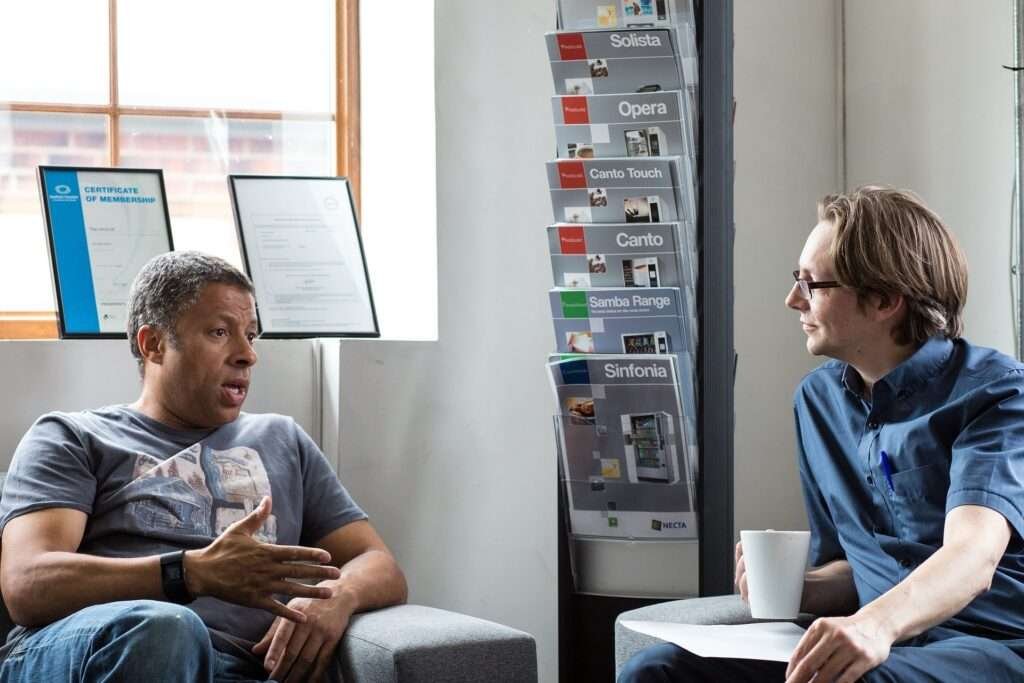Do social situations make you want to retreat into your shell? And do you want to stop being shy? If the answer is yes, fear not, because there are plenty of things you can do to reduce your shyness. In this article, we’ll explore five concrete tips on how to stop being shy, empowering you to have social interactions with confidence.
Table of Contents
What Is Shyness?
Before delving into the strategies, let’s take a moment to understand shyness. If you’re shy you feel discomfort and awkwardness in social situations. People who are shy often feel self-conscious, nervous, or anxious when interacting with others, especially in unfamiliar or large social settings. You might even avoid social situations.
Does that sound like you? Then remember that shyness is not a permanent personality trait. Rather, it’s a behavioral pattern that can be changed with effort and practice. Recognizing that shyness is a learned behavior is the first step towards overcoming it: you are not your shyness.
Shyness can be hard to deal with, and it can make both your personal life and professional life more difficult. So it’s a great idea to learn how to stop being shy.
Once you reduce your shyness, you will notice that you are perfectly capable of having good conversations with others, you can make friends, and you too can learn how to give a presentation without feeling anxious.
So, let’s dive into the 5 concrete tips on how to stop being shy!
What Causes Shyness?
Shyness can be caused by multiple factors. Some of the most common causes are:
- Your environment. For example, your parents have a large influence on who you are. If they were very protective and anxious, you might have trouble with the uncertainty of social interactions.
- Your genes. There are indications that shyness can be caused by certain genes. This, however, does not mean that you can’t reduce your shyness.
- Your experiences. Bad experiences in your past, like being bullied, can have a big impact on the way you interact with others now.

Tip 1: Embrace Small Talk to Build Confidence
One effective way how to stop being shy is by mastering the art of small talk. Small talk acts as a social lubricant, easing you into conversations and helping you build confidence gradually.
Start by initiating simple conversations with friends, family, or colleagues about neutral topics like the weather or current events. Use these opportunities to practice maintaining eye contact and projecting your voice. If you don’t know what to say, be sure to check out our guide on how to never run out of things to say.
Transitioning from small talk to more in-depth conversations becomes smoother as you become more comfortable with the initial steps. Remember, small talk is the gateway to meaningful connections and can be a powerful tool in overcoming shyness.
Let’s bring this tip to life with a brief example conversation between three people at a networking event. This example showcases how initiating small talk, finding common ground, and expressing genuine interest can lead to a meaningful and positive interaction at a networking event.
EXAMPLE
John enters the venue and notices a small group of professionals engaged in conversation. He decides to approach and join the discussion.
John: (approaching with a smile) Hi there! Mind if I join the conversation?
Sarah: Of course, not at all! My name’s Sarah and that’s Mark. We were just talking about the recent advancements in AI technology.
John: (nodding) That’s fascinating! I’m John, by the way. I couldn’t help but overhear your discussion about AI. What are your thoughts on the impact it might have in the coming years?
Mark: Oh, I think it’s incredible. We were just discussing how it’s changing the landscape of data analysis in our industry.
John: (actively listening) Absolutely. I’ve actually been involved in a project that touched on AI-driven analytics. It’s amazing how it enhances decision-making. Have any of you had similar experiences?
Sarah: (nodding) Definitely. We implemented a similar system last year, and the results were impressive. How about you, John?

Tip 2: Challenge Negative Thoughts with Positive Affirmations
Shyness often stems from negative self-perception and self-doubt. To counteract these thoughts, integrate positive affirmations into your daily routine. Affirmations are powerful statements that reinforce positive beliefs about yourself, which is one way how to stop being shy. Instead of focusing on what could go wrong in social situations, remind yourself of your strengths and unique qualities. If you struggle with this, you might find our self-talk exercises helpful.
For instance, start your day by looking in the mirror and saying, “I am confident, and I have valuable contributions to make.” Repeat these affirmations consistently to rewire your thought patterns. Over time, you’ll notice a positive shift in your mindset, allowing you to approach social interactions with a newfound sense of self-assurance.
Imagine you’re preparing to give a presentation at work. As you start setting up your slides and reviewing your notes, negative thoughts begin to creep in, casting doubt on your abilities. Let’s delve into the internal monologue and see how positive affirmations can be employed to counteract these negative thoughts.
EXAMPLE
Negative Thought: “I’m going to mess up this presentation. What if I forget important points, and everyone thinks I’m not competent?”
Positive Affirmation: “No, I’ve prepared thoroughly for this presentation. I’ve put in the time and effort to research and organize my content. I am well-versed in the subject matter, and my insights are valuable. I have a unique perspective to share.”
Negative Thought: “What if they ask me challenging questions, and I can’t answer them?”
Positive Affirmation: “I am capable of handling questions. I’ve anticipated potential queries and have thoughtful responses prepared. Even if I encounter a question I didn’t foresee, I can rely on my knowledge and problem-solving skills to address it confidently.”
By consciously engaging in this internal dialogue and countering negative thoughts with positive affirmations, you reshape your mindset and approach the upcoming presentation with increased confidence and self-assurance.

Tip 3: Gradual Exposure to Social Situations
Facing your fears head-on is a proven method for overcoming shyness. Gradual exposure to social situations allows you to desensitize yourself to the anxiety associated with social interactions. Begin with low-pressure situations, such as attending small gatherings or joining clubs with shared interests.
As you become more accustomed to socializing, gradually challenge yourself with more significant events or unfamiliar environments. This step-by-step approach helps build resilience and allows you to adapt to social situations without feeling overwhelmed. Remember, practice makes perfect, and the more you expose yourself to social scenarios, the more confident you’ll become.
EXAMPLE
Meet Alex, a software engineer with a passion for technology but a lingering discomfort in social situations. His shyness has, at times, held him back from fully engaging in team discussions and networking events. Recognizing the need for change, Alex decides to gradually expose himself to various social scenarios.
Step 1: Casual Team Meetings
At first, Alex begins with low-pressure situations within the familiar setting of his workplace. He actively participates in casual team meetings, where discussions often revolve around project updates or general team matters. By contributing his thoughts in these less formal settings, he becomes more accustomed to expressing himself and gradually builds confidence.
Step 2: Lunch Gatherings
Encouraged by his positive experiences in team meetings, Alex takes the next step by joining his colleagues for lunch gatherings. These more relaxed settings provide opportunities for casual conversations outside the context of work. Alex starts by actively participating in discussions about shared interests like movies or hobbies, allowing him to connect with his colleagues on a personal level.
Step 3: Industry Meetups
To further expand his social exposure, Alex decides to attend industry-related meetups and networking events. These gatherings introduce a level of formality and a mix of unfamiliar faces. However, having already practiced in more familiar settings, Alex is better prepared to initiate conversations, exchange ideas, and even share his experiences during discussions or panel sessions.
Step 4: Joining a Professional Group
Inspired by his progress, Alex takes a bold step by joining a professional group related to his field. This group not only aligns with his interests but also presents opportunities for more in-depth discussions and collaborations. By actively participating in group activities, such as workshops or collaborative projects, Alex builds stronger connections within the professional community.
Step 5: Hosting a Knowledge Sharing Session
The culmination of Alex’s journey involves taking a leadership role. He decides to host a knowledge-sharing session within his team, where he shares his expertise on a specific topic. This not only showcases his skills but also positions him as a valuable contributor to the team. The positive feedback from his colleagues reinforces the transformation he’s undergone.

Tip 4: Develop Active Listening Skills
Active listening is a key skill in effective communication and can be a game-changer in overcoming shyness. Rather than focusing on your own insecurities, shift your attention to others by practicing active listening. This involves giving your full attention to the speaker, nodding to show understanding, and responding thoughtfully.
By becoming a better listener, you shift the focus away from yourself, alleviating the pressure associated with shyness. Moreover, active listening fosters genuine connections with others, making social interactions more enjoyable and less intimidating. As you hone this skill, you’ll find that your confidence naturally grows.
EXAMPLE
Meet Alex and Jamie, two friends catching up at their favorite coffee shop. Alex has recently faced some challenges at work, and Jamie is eager to lend a supportive ear. The conversation unfolds with Jamie practicing active listening:
Alex: Hey Jamie, thanks for meeting up. Work has been quite hectic lately, and I needed someone to talk to.
Jamie: Of course, Alex. I’m here for you. Take your time, and feel free to share whatever you’re comfortable with.
Alex: Well, you know, the new project has been demanding, and there’s been a lot of pressure to meet deadlines. It’s been a bit overwhelming.
Jamie: (nodding) I can imagine that juggling a new project and tight deadlines can be stressful. How have you been managing the workload?
Alex: It’s been tough. There’s been a lot of back-and-forth with the team, and sometimes it feels like everyone has different expectations. It’s been challenging to keep everyone on the same page.
Jamie: (reflecting) It sounds like communication within the team has been a bit challenging. Can you tell me more about the specific issues you’ve encountered?
Alex: Yeah, it’s like we’re all speaking a different language sometimes. I’ve tried to clarify things, but it feels like we’re not always on the same wavelength.
Jamie: (summarizing) So, it seems that the main challenge is communication within the team, and despite your efforts to clarify, there’s still a disconnect. How have you been dealing with this personally?
Alex: Honestly, it’s been frustrating. I’ve been staying late to try and catch up on things, but it’s affecting my work-life balance. I feel like I’m running on empty.

Tip 5: Seek Support and Professional Guidance
Breaking free from shyness is a journey, and you don’t have to embark on it alone. Seek support from friends, family, or mentors who can provide encouragement and guidance on how to stop being shy. Share your goals with them, and let them be a source of motivation as you navigate through social challenges.
Additionally, consider seeking professional guidance from a therapist or counselor. These professionals can offer personalized strategies and insights to help you overcome shyness. Therapy provides a safe space to explore the root causes of your shyness and develop coping mechanisms to navigate social situations more confidently.

Conclusion: How Can I Stop Being Shy?
In conclusion, learning how to stop being shy is a transformative process that involves self-reflection, practice, and a willingness to step out of your comfort zone. Embrace small talk, challenge negative thoughts with positive affirmations, expose yourself gradually to social situations, develop active listening skills, and seek support when needed.
By incorporating these concrete tips into your daily life, you’ll discover the power within you to stop being shy and embrace a more confident and fulfilling social life. Good luck!




